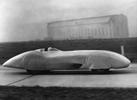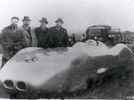
Em 28 de janeiro de 1938, com Rudolf Caracciola ao volante, o W125 marcou o recorde mundial de velocidade em uma estrada destinada a carros de passeio, ao atingir 432,7 Km/h (268.8 MPH), percorrendo a distância de um quilômetro na Autobahn, na Alemanha, entre Frankfurt e Darmstadt.
Mesmo após o recorde ter sido quebrado em 4 de novembro de 2017, quando o Koenigsegg Agera RS registrou um novo recorde mundial, ao atingir a velocidade média de 445,54 km/h (276.9 MPH) ao longo de um quilômetro, a Mercedes-Benz faz questão de celebrar os 80 anos do feito, afinal de contas, mesmo toda a tecnologia criada para os carros ao longo das décadas não foi capaz de ultrapassar a marca do W125.
A longevidade dos registros do W125 é realmente impressionante, e pode-se imaginar que custou muito esforço para se atingir estas velocidades no final da década de 1930. Para começar, a carroceria precisava ser a menos resistente ao ar possível. Quatro décadas depois, as medidas feitas no túnel de vento mostraram que a carroceria tinha um coeficiente de arrasto (Cx) de apenas 0.170.
Só para comparação, o Volkswagen XL1, carro que é considerado o mais aerodinâmico do mundo, embora seja muito limitado, tem um Cx de 0.1889.
Originalmente, o motor 5.6 V12 tinha 765 CV de potência, mas, com carburadores a mais, ganhou 29 CV, e foi usado oito semanas antes para uma tentativa de registro de recorde de velocidade que foi abortada. Durante aquele período, os engenheiros procuraram otimizar a mistura ar/combustível e a confiabilidade de cada um dos 12 cilindros. Além disso, a carroceria foi redesenhada do zero para melhorar a eficiência aerodinâmica, que foi trabalhada por fabricantes de aviões.
Parece muito improvável que os novos registros estabelecidos pela Koenigsegg durarão mais de oito décadas, considerando que a Bugatti, com seu Chiron, e a Hennessey, com seu Venom F5, anunciaram planos para tentar reivindicar o registro de velocidade máxima para um carro de produção. Mesmo a Koenigsegg sugeriu que o Agera RS pudesse quebrar a barreira de 300 MPH (482,8 km/h), então só nos resta aguardar.
Não custa lembrar que 28 de janeiro de 1938 foi também o dia em que Bernd Rosemeyer morreu, a bordo de seu Auto Union Streamliner, no mesmo local, ao tentar bater o recorde recém-estabelecido por Rudolf Caracciola. Em um esforço para aumentar a velocidade máxima, apesar de uma medição de vento contrário à direção que o carro tomaria, Rosemeyer, em sua terceira e última tentativa, às 11:47, perdeu o controle do carro, derrapou para a esquerda, depois para a direita.
Já fora da estrada, o carro pairou no ar e colidiu em um aterro de uma ponte, enquanto Rosemeyer foi projetado para fora do carro. Bernd morreu no local.
Inspiring to the present day: Caracciola’s 432.7 km/h on a public road on 28 January 1938: A Mercedes-Benz record for practically all time
On 28 January 1938, driving the Mercedes-Benz W 125 twelve-cylinder record-breaking car, racing driver Rudolf Caracciola established a world speed record on a public road: he reached 432.7 km/h over a flying kilometre on the autobahn between Frankfurt am Main and Darmstadt. A shadow was cast on this success by the fatal accident of a competitor, Auto Union racing driver Bernd Rosemeyer, on the same day. Nonetheless, the fascination for high speed has lost none of its appeal to this day: the record was only broken almost 80 years later, in November 2017. What remains unbroken is the enthusiasm for the aesthetic appeal and technical pioneering spirit of the brand. An exciting cooperation project between the Mercedes-Benz design department and the University of Applied Sciences in Munich has concerned itself with the design reinterpretation of such record-breaking cars – using innovative, cutting-edge electric drive systems.
Stuttgart. Records such as those set by Rudolf Caracciola driving a Mercedes-Benz on 28 January 1938 are an inspiration to the present day. For design students, for example: in 2016 and 2017, the “Electric High Speed” project initiated by the Chief Design Officer of Daimler AG, Prof. Dr. h.c. Gorden Wagener, working in cooperation with the Faculty of Design at the University of Applied Sciences in Munich, developed design studies based on future-orientated technologies for wheel-driven high-speed record-breaking vehicles with electric drive systems. Under the guidance of Prof. Othmar Wickenheiser, would-be automobile designers found particular inspiration in the body shapes of the historic Mercedes-Benz record-breaking cars of the 1930s, and gave free rein to their creativity. The result is outstanding design concepts for record-breaking cars capable of over 800 km/h. Almost literally electrifying insights into the project are provided by the recently published book “Electric High Speed” (Shaker Media, Aachen, 524 pages, € 119.80, ISBN 978-3-95631-626-5). Some of the design studies developed as part of the project have been implemented in the form of 1:4-scale models. The brand plans to present these and other impressive models of historical Mercedes-Benz record-breaking cars at the Techno Classica specialist fair in Essen (21 to 25 March 2018).
Review. The 1937 motor racing year was going outstandingly for Mercedes-Benz: the brand won the European Grand Prix as a major triumph. And it wanted to cap this with an equally stunning world record. An undertaking that was doomed to failure. During the record attempt week in Frankfurt am Main in October 1937, the W 125 with a 5.6-litre V12 engine was unable to better the competing cars of Auto Union. The Stuttgart-based brand withdrew the car from the competition – and decided that the car should be comprehensively developed further for the next record attempt. Within just eight weeks, Rudolf Uhlenhaut, technical manager of the racing department, and the Board of Management member for development, Max Sailer, had the necessary work under way. The next record-breaking attempt was to take place on 28 January 1938.
The instructions issued to the engineers were to modify the chassis and engine and develop a completely new vehicle body. The reason was above all the excessive front axle lift of the 1937 version, which at times led to loss of steerability.
Aerodynamics: Ideas from the aircraft industry
Mercedes-Benz received major impulses from the aircraft industry for its new vehicle body: among others, it was the development departments of aircraft manufacturers Ernst Heinkel and Willy Messerschmitt that made the recommendation to shorten the front overhang and give the car a rounder front end. In addition, the front end was lowered and more sharply tapered. This had the desired effect of reducing front axle lift.
A longer and more raised rear end reduced lift at the rear axle. The cross section of the car was also more heavily rounded off, which reduced susceptibility to crosswinds. And finally the cockpit glazing was modified to resemble the shape and cross section of a teardrop. Racing driver Rudolf Caracciola, the European Champion in 1935 and 1937, had previously rejected such a solution owing to the risk of distorted visibility. Then Mercedes-Benz, working with a supplier, found a visually and aerodynamically acceptable solution. The uncompromisingly streamlined form of the car was also accentuated by the covered wheel arches.
Engine cooling: Iced water rather than airflow
The diameter of the air inlets in the front of the streamlined body was usually small. This was made possible by the innovative ice-cooling system of the car for the record attempt. The radiator was housed in a container holding 48 litres of water and 5 kilograms of ice. If needed, an additional cooling effect could be achieved with dry ice. This eliminated a strong airflow through the radiator, which would have made itself felt with a higher drag coefficient.
The suggestion to use ice-cooling came from the German test institute for aviation in Berlin-Adlershof. Four decades later, measurements in the Mercedes-Benz wind tunnel showed how successful equipping the W 125 record attempt car with its new body was. In its race configuration, the Silver Arrow achieved an excellent drag coefficient of cd = 0.170.
The V12 with a displacement of 5577 cubic centimetres which had been used during the aborted record attempt in October 1937 was completely stripped down and optimised. Its reliability was to be increased, e.g. by means of a richer combustion mixture and reinforced piston pins. Other improvements included nickel-plated piston crowns to reduce the risk of charring. The piston clearance was also increased. And finally Georg Scheerer in the engine workshop of the racing department ensured a steady supply of fuel/air mixture to each cylinder.
Test bench trials confirmed the success of all this work. On 29 December 1937, an output measurement prior to installation in the vehicle showed an output of 525 kW (714 hp) with no additional slide carburettor. On 6 January 1938, Scheerer minuted that with these additional carburettors, the output would be around 563 kW (765 hp). This was 21 kW (29 hp) more than the engine had achieved during the record-breaking attempt eight weeks earlier.
“The car hugs the road beautifully”
This was a record-breaking attempt that nobody had previously dared to embark on. And it paid off: in the morning of 28 January 1938, just after 8 a.m., Rudolf Caracciola achieved the highest speed ever recorded on a public road on the autobahn between Frankfurt am Main and Darmstadt, later the A 5 federal autobahn, which had been opened in May 1935. He clocked a speed of 432.7 km/h over the flying kilometre, and also broke the record for the flying mile with a speed of 432.4 km/h. In each case the speeds were calculated as the mean between runs in both directions. Caracciola praised the vehicle in his later biography: “The car hugs the road beautifully. This is already noticeable on the approach to the test stretch. It feels quite different from the design of last year.” This impressively demonstrated the success of the aerodynamic improvements with the fundamentally newly developed, streamlined body.
Auto Union attempted to break this new Mercedes-Benz record on that same day, however Bernd Rosemeyer, the competing company’s most successful racing driver, suffered a fatal accident when his car was caught by a gust of wind at top speed and veered off the road.
Caracciola’s speed record on a public road remained unbroken for almost eight decades. It was only on 4 November 2017 that it was broken with a new record of 445.54 km/h. The vehicle concerned had almost twice the engine output. This makes the record-breaking Mercedes-Benz W 125 a shining example of efficiency to this day. The original car from 1938 now occupies a place of honour in the Mercedes-Benz Museum: in the presentation of record-breaking cars in Legend Room 7 – “Silver Arrows – Races and Records”.




Postar um comentário